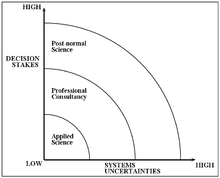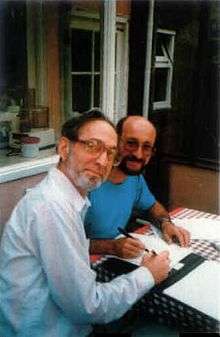Post-normal science


Post-normal science represents a novel approach for the use of science on issues where ‘facts uncertain, values in dispute, stakes high and decisions urgent’. PNS was developed in the nineties by Silvio Funtowicz and Jerome R. Ravetz.[1][2][3] It can be considered as a reaction to the styles of analysis based on risk and cost-benefit analysis prevailing at that time, and as an embodiment of concepts of a new "critical science" developed in previous works by the same authors.[4][5] In a more recent work PNS is described as 'the stage where we are today, where all the comfortable assumptions about science, its production and its use, are in question'.[6]
Context
In 1962, Thomas Kuhn's The Structure of Scientific Revolutions introduced the concept of normal science as part of his theory that scientific knowledge progresses through socially constructed paradigm shifts, where normal science is what most scientists do all the time and what all scientists do most of the time. The process of a paradigm shift is essentially as follows:
- from normal science (the rules are agreed upon or disagreed upon in debates that cannot be concluded; science is puzzle solving, but some contradictions in theory cannot be resolved)
- to revolutionary science (important rules are called into question; contradictions may be resolved; paradigms shift)
- to new normal science (new rules are accepted, science returns to puzzle solving under new rules).
An illustration of the theory in practice is the Copernican revolution, where Copernicus’ idea of a (sun-centered) solar system was largely ignored (not in the rules) when first introduced; then Galileo was deemed a heretic for supporting the idea (rules called into question); and finally, after a revolution in cosmology, the solar system became an obvious and foundational part of scientific knowledge (new rules).
Another example is the question of whether light is a particle or a wave. For a long time there was debate on this point. Advocates on both sides had many valid arguments based on scientific evidence but were lacking a theory that would resolve the conflict. After a revolution in thinking, it was realized that both perspectives could be true.
Physicist and policy adviser James J. Kay described post-normal science as a process that recognizes the potential for gaps in knowledge and understanding that cannot be resolved in ways other than revolutionary science. He argued that (between revolutions) one should not necessarily attempt to resolve or dismiss contradictory perspectives of the world, whether they are based on science or not, but instead incorporate multiple viewpoints into the same problem-solving process.
Content
"At birth Post-normal science was conceived as an inclusive set of robust insights more than as an exclusive fully structured theory or field of practice".[7] Some of the ideas underpinning PNS can already be found in a work published in 1983 and entitled "Three types of risk assessment: a methodological analysis" [8] This and subsequent works [1][2][3][4] show that PNS concentrates on few aspects of the complex relation between science and policy: the communication of uncertainty, the assessment of quality, and the justification and practice of the extended peer communities.
The theory is illustrated by its well known ‘quadrant-rainbow’ with three zones (see diagram). The two axes are, respectively, ‘Systems Uncertainties’ and ‘Decision Stakes’. The three quarter-circular zones are, respectively, Applied Science, Professional Consultancy, and Post-Normal Science. Different standards of quality and styles of analysis are appropriate to different regions in the diagram, i.e. Post-normal science does not claim relevance and cogency on all of science's application but only on those defined by the PNS's mantram, with a fourfold challenge: ‘facts uncertain, values in dispute, stakes high and decisions urgent’.
Today Post-normal science is intended as applicable to most instances where the use of evidence is contested due to different norms and values. For Peter Gluckman (2014), chief science advisor to the Prime Minister of New Zealand, post normal science approaches are today appropriate for a host of problems including "eradication of exogenous pests […], offshore oil prospecting, legalization of recreational psychotropic drugs, water quality, family violence, obesity, teenage morbidity and suicide, the ageing population, the prioritization of early-childhood education, reduction of agricultural greenhouse gases, and balancing economic growth and environmental sustainability".[9] For Carrozza [10] PNS can be "framed in terms of a call for the ‘democratization of expertise’", and as a "reaction against long-term trends of ‘scientization’ of politics—the tendency towards assigning to experts a critical role in policymaking while marginalizing laypeople". For Mike Hulme (2007), writing on The Guardian Climate change seems falls into the category of issues which are best dealt with in the context of PNS and notes that "Disputes in post-normal science focus as often on the process of science - who gets funded, who evaluates quality, who has the ear of policy - as on the facts of science".[11] A recent review of the history and evolution of PNS, its definitions, conceptualizations, and uses can be found in Turnpenny et al., 2010.[12] There has been recently an increased reference to post-normal science, e.g. in Nature (journal).[13][14][15]
Criticism
A criticism of post-normal science is offered by Weingart (1997)[16] for whom Post-normal science does not introduce a new epistemology but retraces earlier debates linked to the so-called "finalization thesis".
Special issues
The journal Futures devoted a special issue to "Post normal times" in 2011.[17] A summary of the abstracts can be found on the NUSAP net.
Recent production
A group of scholars of PNS orientation has published in 2016 a volume on the quality control crisis of science.[18] The volume discusses inter alia what this community perceive as the root causes of the present crisis.[19]
Quantitative approaches
Among the quantitative styles of analysis which make reference to post-normal science one can mention NUSAP for numerical information, sensitivity auditing for indicators and mathematical modelling and MUSIASEM in the field of system ecology.
See also
References
- 1 2 Funtowicz, S. O. and Ravetz, J. R., 1991. "A New Scientific Methodology for Global Environmental Issues", in Costanza, R. (ed.), Ecological Economics: The Science and Management of Sustainability: 137–152. New York: Columbia University Press.
- 1 2 Funtowicz, S. O. and Ravetz, J. R., 1992. "Three types of risk assessment and the emergence of postnormal science", in Krimsky, S. and Golding, D. (eds.), Social theories of risk: 251–273. Westport, Connecticut: Greenwood.
- 1 2 Funtowicz, S. and Ravetz, J., 1993. "Science for the post-normal age", Futures, 31(7): 735-755.
- 1 2 Funtowicz, S. and Ravetz, J., 1990. Uncertainty and quality in science for policy. Dordrecht: Kluwer Academic Publishers.
- ↑ Ravetz, J. R., 1971. Scientific Knowledge and its Social Problems. Oxford University Press.
- ↑ Ravetz, J.R., 2006, The No nonsense guide to science, New Internationalist.
- ↑ Funtowicz, S., 2016, personal correspondence.
- ↑ Funtowicz, S. O. and Ravetz, J. R. (1985), Three types of risk assessment: a methodological analysis, in C. Whipple and V. T. Covello (Eds), Risk Analysis in the Private Sector, pp 217-232 (Plenum, New York).
- ↑ Gluckman, P., 2014, Policy: The art of science advice to government, Nature, 507, 163–165.
- ↑ Carrozza, C. (2015). Democratizing Expertise and Environmental Governance: Different Approaches to the Politics of Science and their Relevance for Policy Analysis. Journal of Environmental Policy & Planning, 17(1), 108-126.
- ↑ Hulme, Mike (March 14, 2007). "The appliance of science". The Guardian.
- ↑ Turnpenny, J., Jones, M., & Lorenzoni, I. (2010). Where now for post-normal science? A critical review of its development, definitions, and uses. Science, Technology & Human Values, 0162243910385789.
- ↑ Gluckman P. (2014) "Policy: The art of science advice to government". Nature, 507, 163-165.
- ↑ Grinnell, F. (2015), "Rethink our approach to assessing risk", Nature, 522, 257.
- ↑ Nature, Editorial, (2016). "Future present", 531, 7–8.
- ↑ Weingart, P. From "Finalization" to "Mode 2": old wine in new bottles?. Social Science Information 36 (4), 1997. Pp. 591-613.
- ↑ Davies, M.W., Editor, 2011, Special Issue: Postnormal Times Futures, Volume 43, Issue 2, Pages 135-228 (March 2011).
- ↑ Benessia, A., Funtowicz, S., Giampietro, M., Guimarães Pereira, A., Ravetz, J., Saltelli, A., Strand, R., van der Sluijs, J., 2016. The Rightful Place of Science: Science on the Verge. The Consortium for Science, Policy and Outcomes at Arizona State University.
- ↑ Ravetz, J., 2016, How should we treat science's growing pains? The Guardian, June 8th 2016.
Bibliography
- Ravetz, Jerome R. (1979). Scientific knowledge and its social problems. Oxford: Oxford Univ. Press. ISBN 0-19-519721-6.
- Ravetz, J. R. (1986). "Usable knowledge, usable ignorance: incomplete science with policy implications." In Clark, W. C., and R. C. Munn, ed. Sustainable development of the biosphere, p. 415–432. New York: Cambridge University Press.
- Funtowicz, S.O. and J.R. Ravetz (1990). Uncertainty and quality in science for policy. Kluwer Academic Publishers, the Netherlands.
- Ravetz, Jerome R. (2005). The No nonsense guide to science. Oxford: New Internationalist.
External links
- Post-Normal Times
- NUSAP.net
- Introductory lecture to Post Normal Science (requires Internet Explorer)
- Article on The Guardian 14 March 2007
- Article on The Conversation (website) September 26, 2016
- More articles on PNS
- About MUSIASEM
- Special issue on Futures